Best Landmine Exercises to Raise the Bar on Strength Workouts
Whether you have limited space for a home gym or just want to simplify your workout regimen, landmine exercises prove less is more. By using a landmine—a hefty base on the ground with a sleeve to fit the end of a barbell—you unlock new ways to get bigger and stronger.
And given most of the exercises you perform with a landmine are compound movements, you’ll get better results in half the time. There’s no need for dedicated body-part splits to grow your arms, glutes, chest, and legs.
“It’s super useful because you get some stability, yet free range of motion,” says Mike Nelson, Ph.D., C.S.C.S., an associate professor at the Carrick Institute. “For most barbell exercises, like a deadlift or squat, you have to control the bar 100 percent of the time. With the landmine, you still have to control it through space, but you get that little bit of stability because one side is fixed.”
If you’re not familiar with the landmine or haven’t used one before, it can be confusing to look at. In some gyms, it’s a heavy, round piece of equipment attached to the floor with a sleeve designed to fit the end of an Olympic barbell. In other gyms, the landmine sleeve is attached to the bottom leg of a squat or power rack.
In both cases, it holds one side of a barbell in the sleeve. This turns the two-ended bar into an axle or joystick, with the fixed end able to swivel around as the free end is used to move your body in different planes of motion.
Read on to learn how to use a landmine, the equipment’s benefits, and the best functional exercises to make the most of this underused equipment.
Related: What Zone 2 Heart Rate Is and How to Calculate Yours
How to Set Up a Landmine Attachment
Most landmine attachments are made to work with an Olympic barbell—the type of barbell with a 50mm round area on the end designed to hold Olympic-sized plates. (Opposed to a “standard” barbell, which has skinnier diameters on the ends.)
The weight sleeve on an Olympic barbell has a wider area at its end, similar to the hilt of a sword. Landmine attachments are designed as a kind of sheath for the barbell’s weight sleeve, so it’s able to hold it up to the hilt.
To set your barbell up in the landmine, slide one end of the barbell into the sheath of the attachment until the sheath’s end touches the hilt at the end of the barbell’s sleeve. Once this is in place, load your desired weight on the barbell’s other sleeve.
How to DIY a Landmine Setup
Landmine attachments haven’t always been common equipment in weight rooms. If your gym is missing one, you can anchor a barbell the old-school way: Bundle a large towel or two into the corner of the gym wall or a power rack, and place the barbell inside the bundle. This should help it move in a similar way to how it would with the landmine.
But be careful, this setup can slip, potentially causing injury or damage. Before doing this, ask someone at your gym if it’s allowed.
Related: Best Full-Body Workout to Shed Fat and Gain Muscle
12 Best Landmine Exercises
The landmine can let you load the barbell heavy for certain moves, but sometimes, that can be precarious. Getting the barbell up onto your shoulder for a single-arm overhead press, for example, can be awkward and potentially dangerous if it’s too heavy. For this reason, Koziol says, he prefers to use the landmine for higher-rep sets that use slightly less weight, focusing on sets that last 10 to 20 reps. The first time, start with an empty bar—it already weighs 45 pounds. As you get more comfortable, increase the weight in increments of five to 10 pounds.
How to Make a Landmine Workout
Pick five moves (the exercises below comprise landmine leg exercises, landmine back exercises, landmine shoulder exercises, landmine core exercises, and landmine chest exercises) and do 10 to 12 reps of each, catching your breath between sets. Rest 1 or 2 minutes, and repeat twice. This can also be done for time, performing each move for 1 minute.
For every workout, include the snatch, standing reach, or bilateral overhead press. Start conservatively on the weight; when you can perform 3 rounds of 15 reps with ease, begin adding pounds. Do twice a week, changing up moves and increasing weight over time.
1. T-Bar Row

James Michelfelder and Therese Sommerseth
Why It Works
This landmine back exercise creates a great squeeze in the mid-back, while letting you load up with heavier weights than you might be able to with dumbbells.
How to Do It
- Straddle the bar with your feet shoulder-width apart with the weight plates in front of you, to start.
- Take the neutral-grip handle from a cable machine and hook it underneath the bar, just below the plates.
- Bend your knees slightly, and push your hips back to lower your chest while maintaining a flat back until you can grab the neutral-grip handles.
- Maintaining a flat back, deadlift the bar slightly off the floor so that your torso is between a 30- and 45-degree angle with the floor.
- Brace your core.
- Keeping your shoulders down and back, pull the neutral-grip bar towards your navel, driving your elbows back.
- Hold for a beat, then straighten your arms under control.
2. Meadows Row
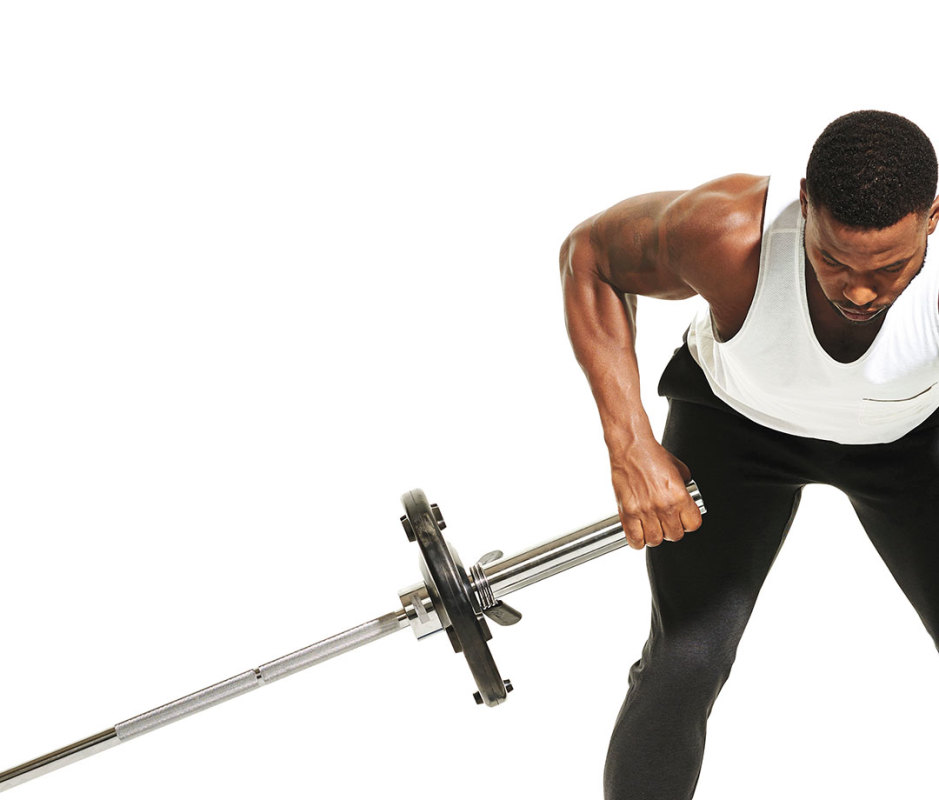
James Michelfelder
Why It Works
Unlike other rows, Nelson says, this landmine shoulder and back exercise encourages you to safely flare your elbows as you pull. If you sit at a computer all day, this is basically the opposite of reaching forward to type, and could help open the chest and shoulders, he says.
How to Do It
- Stand perpendicular to the landmine, with the end of the barbell pointing at the outside of your right foot, to start.
- Now drop your right foot back slightly.
- Push your hips back to bend forward at the waist, and grasp the end of the barbell with your right hand with an overhand grip.
- Raise your right hip slightly higher than your left to create a stretch in your lat.
- Pull the bar up, bending your right elbow out and back, creating a half-T shape with your upper body instead of keeping the arm close to your torso as you would for other rows.
- Hold for a second at the top, then slowly lower the weight.
- Repeat for all your reps on this side, then switch sides and repeat.
3. Cross-Body Row
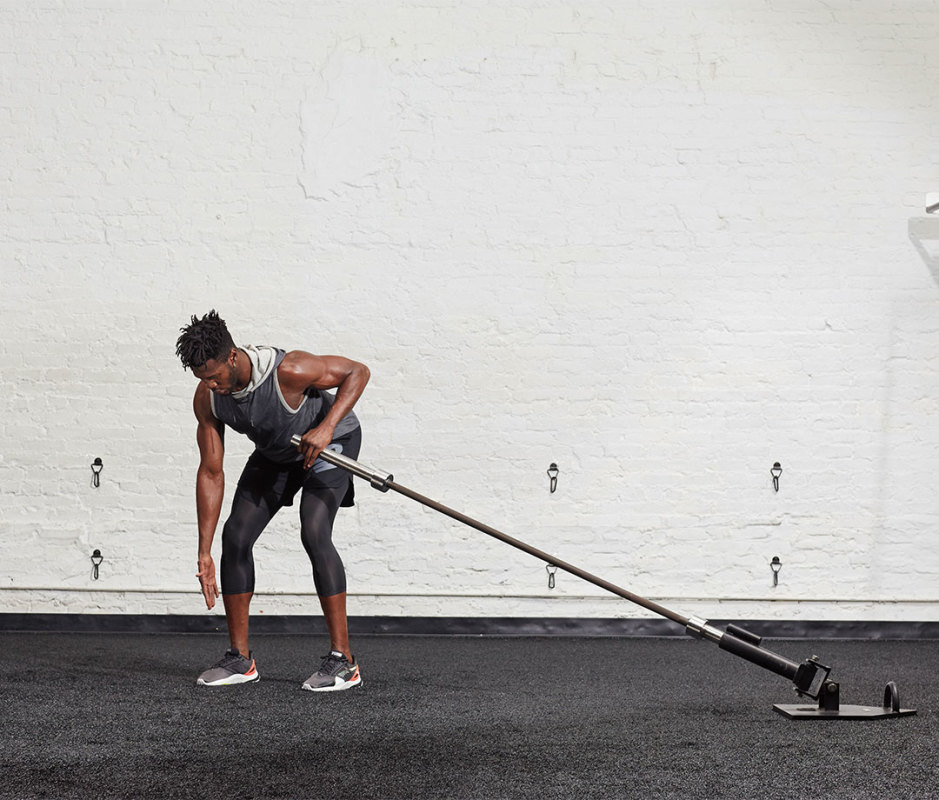
Justin Steele
How to Do It
- Stand with landmine on left, feet slightly staggered, right leg forward, to start.
- Grab barbell in left hand, hinge torso forward, and extend both arms down to start.
- Keeping right fingertips pointed to floor, row left arm so elbow points to back wall.
- Return to start for 1 rep. Do all reps on left side, then switch sides.
4. Landmine Single-Arm Row
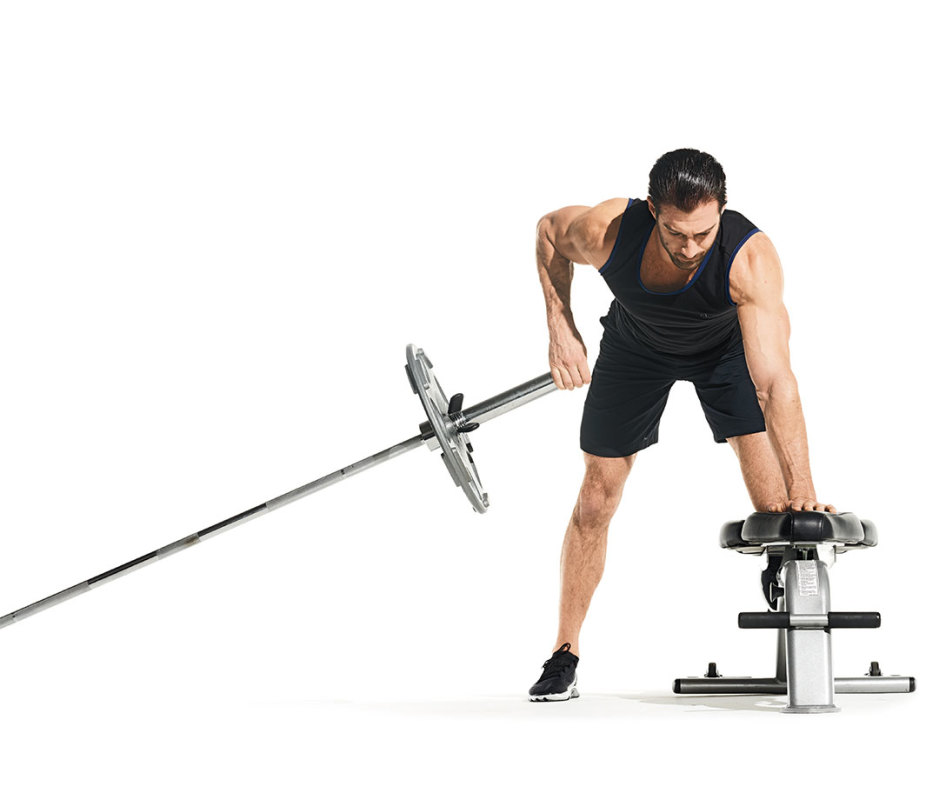
James Michelfelder and Therese Sommerseth
Why It Works
The stability provided by the landmine makes it ideal for single-arm or -leg movements, says Fata-Chan.
How to Do It
- Stand with the landmine on the right, feet slightly staggered, right leg forward, to start. Conversely, you can rest your left knee and hand on a bench for support (shown).
- Grab the barbell in your right hand, hinge your torso forward, and extend arm down.
- Row your right arm so your elbow points to the back wall.
- Return to the start.
- Do all your reps on this side, then switch sides and repeat.
5. Barbell Bus Driver
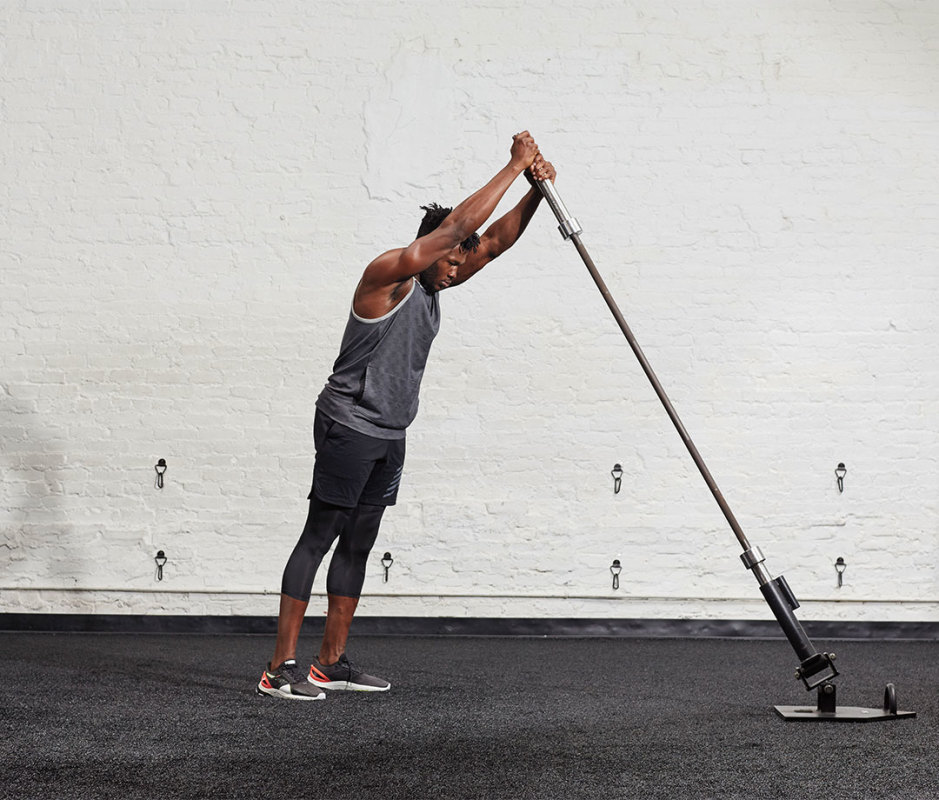
Justi Steele
Why It Works
This rotational landmine core exercise uses the landmine’s swivel feature to challenge your abs with heavy resistance as you twist.
How to Do It
- Stand holding the barbell with both hands and press it up over your head, with elbows slightly bent.
- Pull your shoulder blades back and down, and brace your core.
- Keeping your feet facing the anchor point, rotate the barbell down to your left hip.
- Your hips should rotate with the bar, and your right foot should finish up on the toe, as in a baseball swing.
- Twist the barbell back up overhead and then to your left hip.
- That’s 1 rep.
6. Snatch
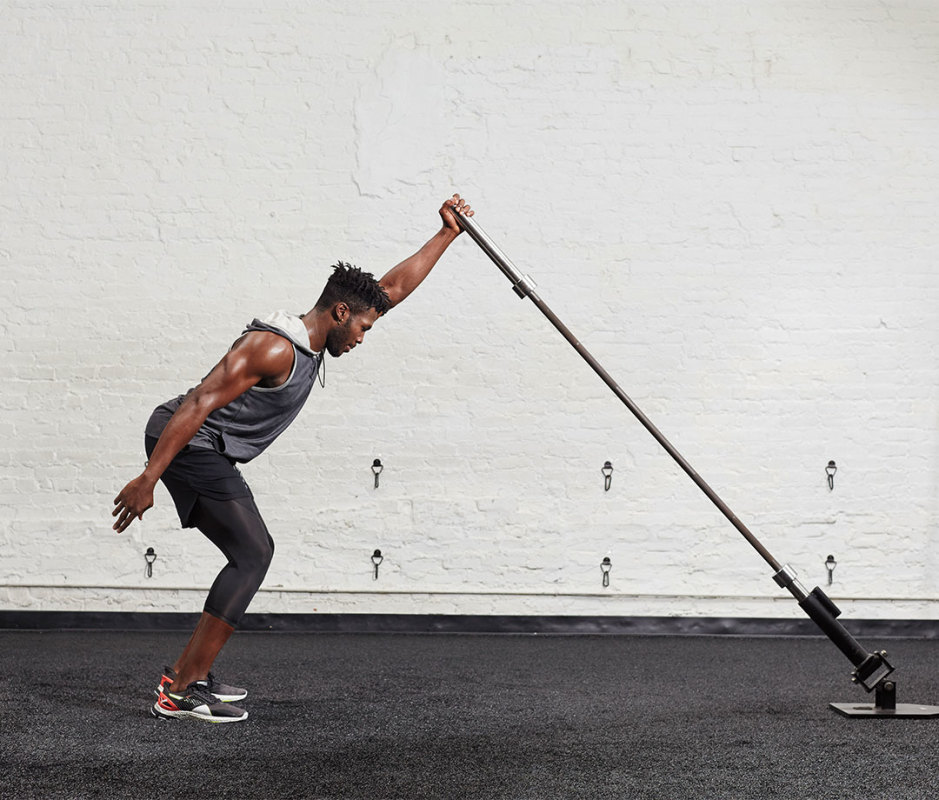
Justin Steele
Why It Works
This move pairs the explosion of a normal snatch with added stability from the bar and the total-body challenge of rotating.
How It Works
- Stand with feet staggered, right foot forward, barbell perpendicular to body and holding it in left hand close to the floor, to start.
- In one fluid movement, explosively spring up, pulling left elbow back, then swing body 90 degrees to face landmine, pushing hips back and extending barbell overhead for 1 rep.
- Do all reps on left side, then switch sides.
7. Single-Arm Half-Kneeling Overhead Press

James Michelfelder
Why It Works
The combination of forward and vertical movement in this press can feel better for the shoulder than traditional overhead pressing, Koziol says.
How to Do It
- To start, assume a half-kneeling position in front of the anchor point, your left knee on the floor, and your right foot flat on the ground with your knee bent 90 degrees.
- Hold the bar by the sleeve in your left hand in front of your shoulder.
- Brace your core.
- Keeping your shoulders and hips square to the anchor point, press the bar up and forward slightly until your elbow is straight and your arm is overhead.
- Return the bar to your shoulder under control.
- That’s 1 rep.
- Perform all your reps on this side, then switch arms and legs, and repeat on the other side.
Related: How to Do a Cossack Squat for Improved Strength and Mobility
8. Single-Leg Romanian Deadlift
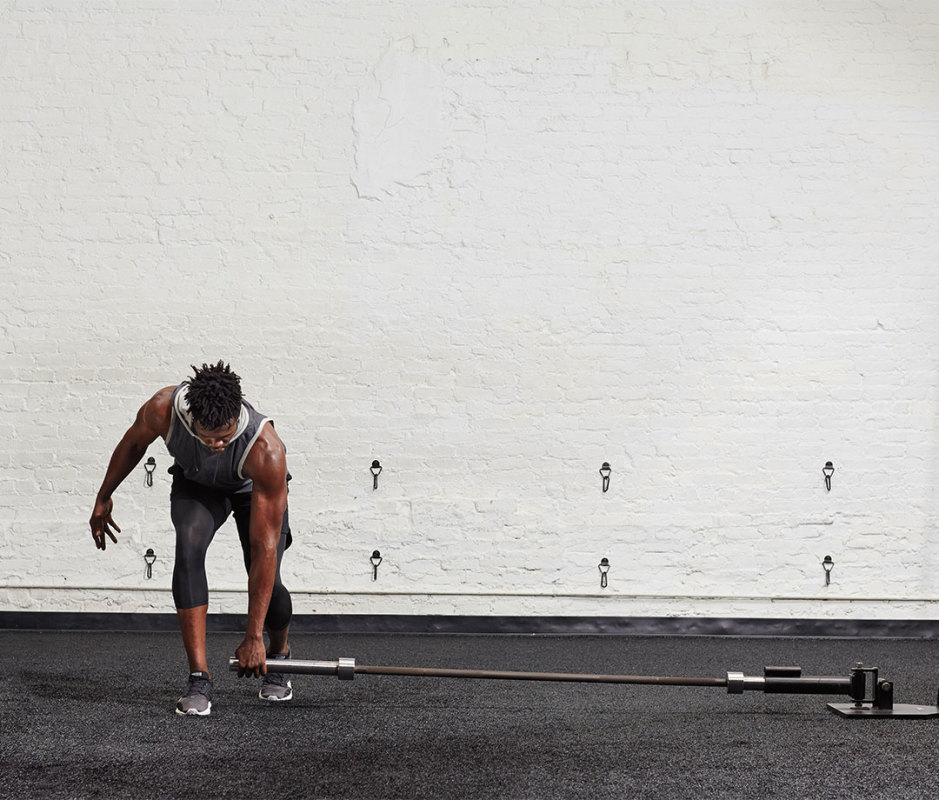
Justin Steele
Why It Works
You won’t fall over! This move is one of Fata-Chan’s favorites, and with good reason, the bar’s partial anchoring provides some stability but still challenges your balance.
How to Do It
- Stand on your right leg while holding the end of the barbell at your left side in your left hand, to start.
- Keeping the right knee slightly bent, perform the deadlift by bending at the hip, extending your left leg behind you for balance, and keeping your weighted arm straight.
- During this movement, make sure your hips remain square.
- Continue lowering the bar until your upper body is parallel to the ground.
- Keeping your back flat, return to the upright position.
- That’s 1 rep.
- Do all your reps on this side, then repeat on the opposite side.
9. Bilateral Overhead Press
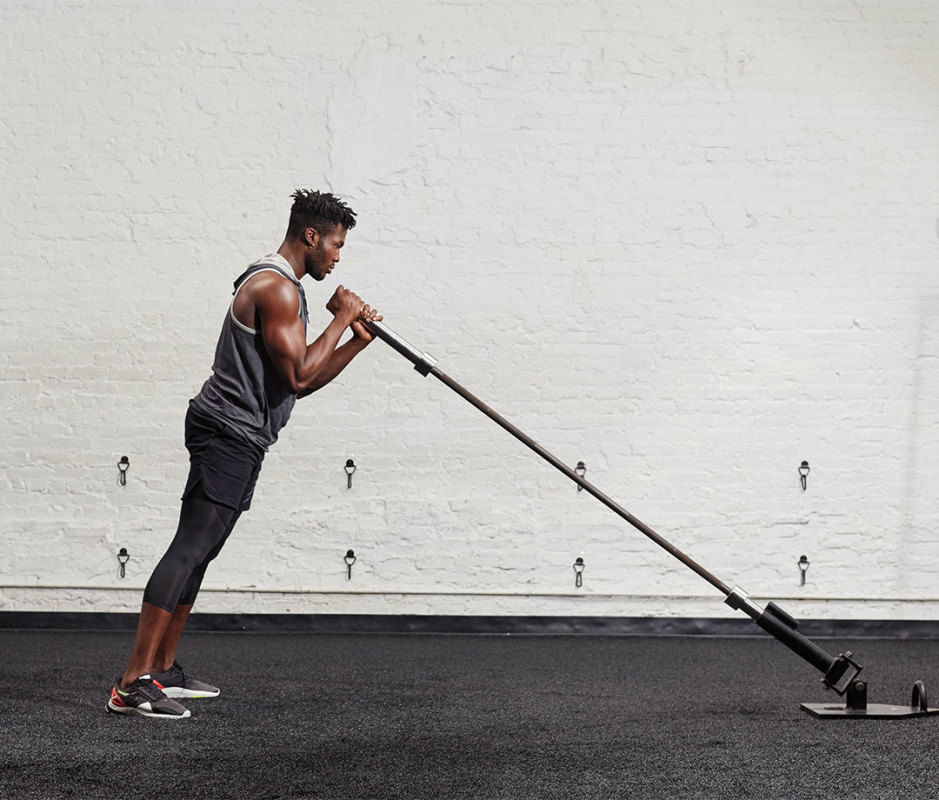
Justin Steele
Why It Works
Lifting with your hands together in a neutral grip will fire upper-body muscles you rarely challenge.
How to Do It
- To start, stand facing the landmine, holding the barbell fist-over-fist, thumbs on top, with the end of the barbell near the top of your chest.
- Step back so your body leans forward and creates a straight line, placing some body weight into the barbell, with your chin gently tucked.
- In a swift movement, engage your hips and press your hands overhead so your arms are alongside your face.
- Bend your elbows to return the barbell to your chest.
- Repeat.
10. Landmine Deadlift
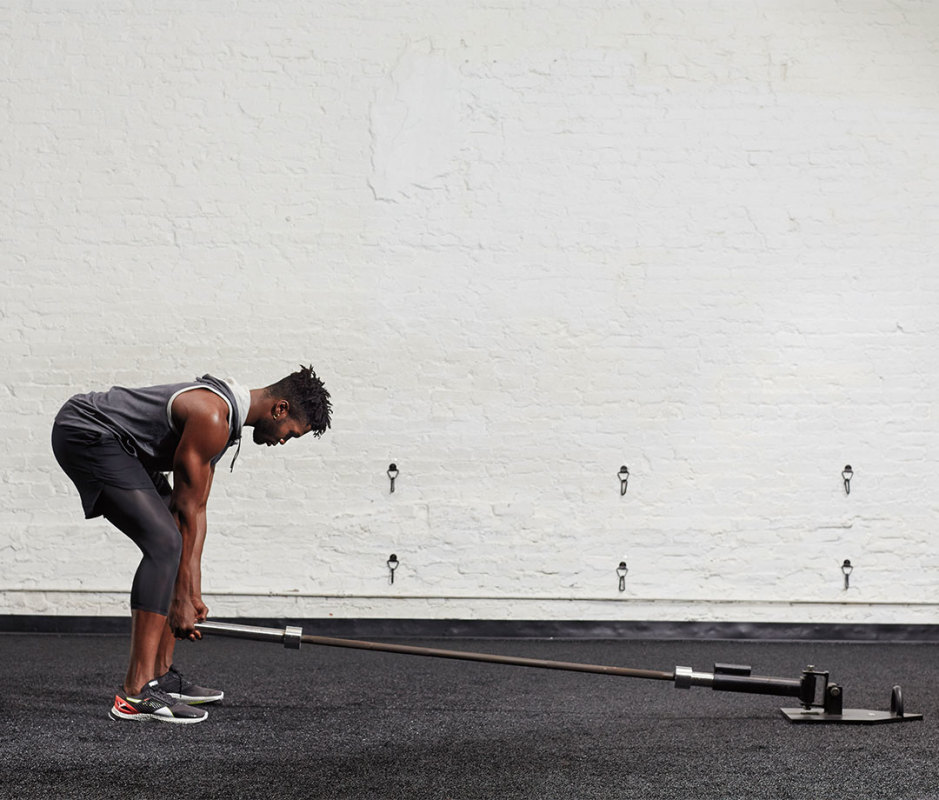
Justin Steele
Why It Works
In addition to added stability, starting with the weight between your legs saves your shins from getting smashed as you lift.
How to Do It
- Stand facing the landmine, with the end of the barbell between your feet, to start.
- Your legs should be slightly wider than hip-width apart to start.
- Grab the barbell by the sleeve, pushing your hips back as you bend over so that your back is flat and your knees are slightly bent. Your arms should be straight.
- Press your hips forward and rise to stand.
- Push your hips back to return the bar to the floor.
- That’s 1 rep.
11. Reverse Lunge
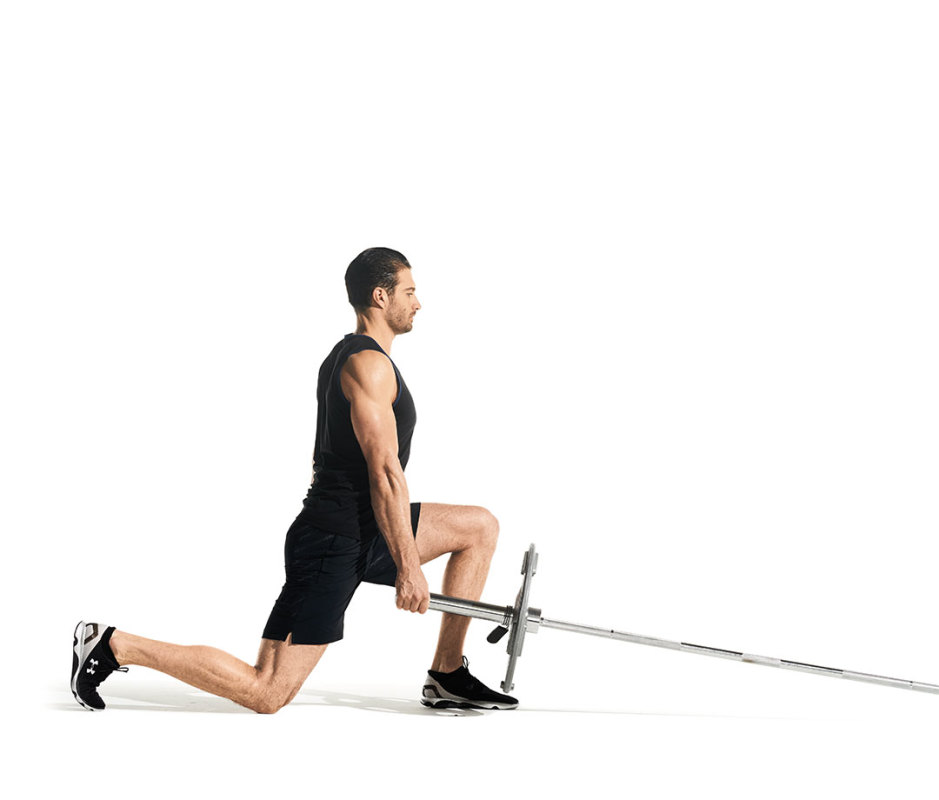
James Michelfelder and Therese Sommerseth
Why It Works
Just like the single-leg deadlift, with this landmine leg exercise, your balance is still challenged as you lunge, but the stability provided by the landmine means you can focus more on the lunge—and potentially lifting heavier than you would with a regular bar or dumbbells.
How to Do It
- To start, stand facing the landmine, with the barbell in your right hand.
- Your arms should be straight down at your sides.
- Take a large lunge step back with your right foot, descending as you step until both knees form 90-degree angles and your right knee hovers just above the floor.
- Push through your back foot to return to standing, and repeat.
- Do all your reps on this side, then switch sides.
12. Standing Reach
Justin Steele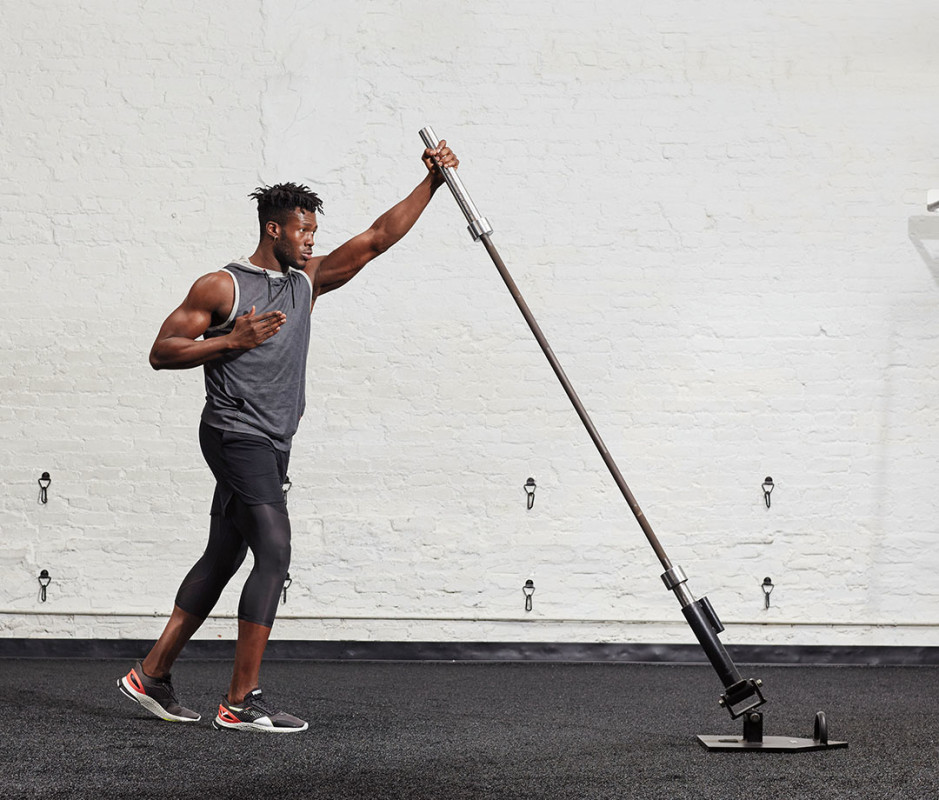
How to Do It
- Stand facing landmine, feet staggered slightly, right foot in front, landmine in left hand close to shoulder.
- Press left arm forward and overhead, and pull right elbow back, to start.
- In a swift motion, drop barbell to shoulder and thrust left hand up at a 45-degree angle, then quickly return to start for 1 rep.
- Do all reps on left side, then switch sides.
13. Goblet Squat
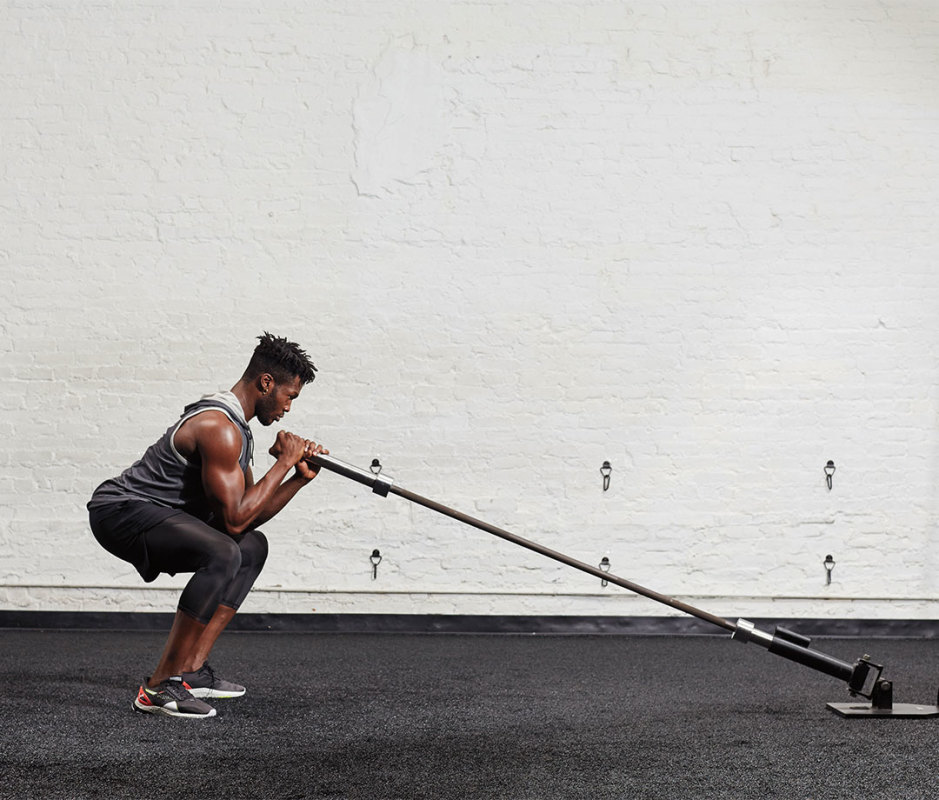
Justin Steele
Why It Works
Because you can press forward on the weight as you squat, Nelson says, it’s possible for most lifters to get a deeper squat with this variation than with a dumbbell.
How to Do It
- Stand facing the landmine with feet around hip distance apart, to start.
- Hold the bar in front of your chest with your fists stacked.
- Bring your elbows together like you’re holding a goblet in front of your chest.
- Step back slightly so your body leans forward.
- Push your hips back to squat, descending until your thighs are at least parallel to the floor.
- Press through your heels to stand back up.
- That’s 1 rep.
14. Landmine Rotational Clean and Press
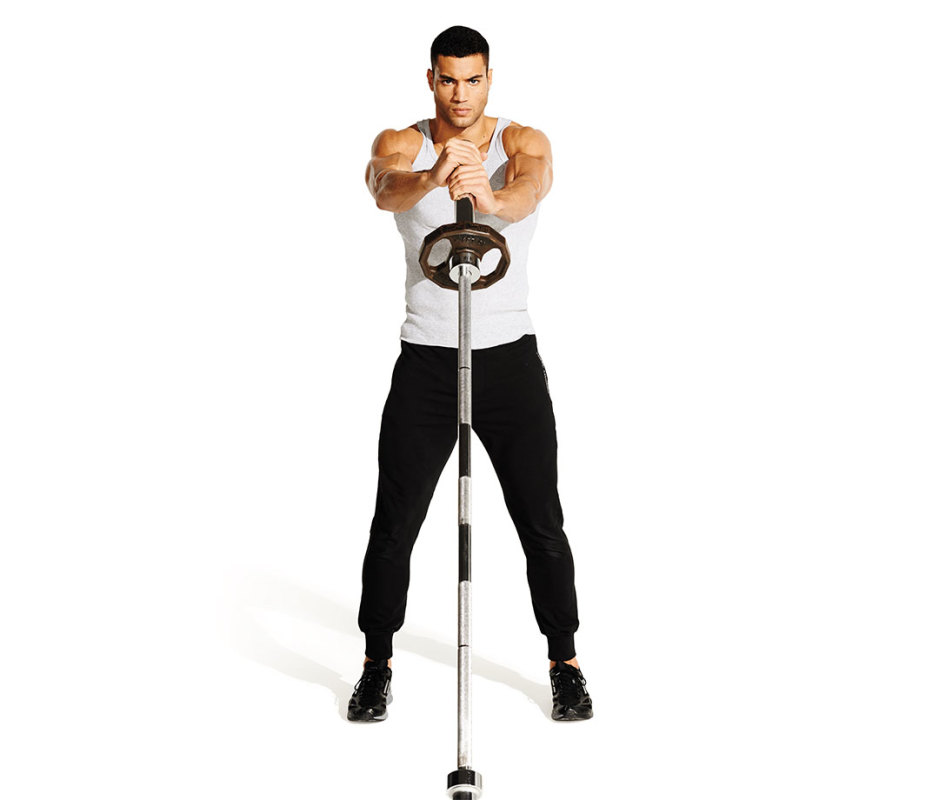
James Mithelfender and Therese Sommerseth
Why It Works
The landmine rotational clean and press combines multiple compound movements in one to strengthen your entire body.
How to Do It
- To start, stand with the barbell in your right hand facing the landmine, with your feet wider than shoulder-width.
- Pivot on your toes 90 degrees to the left, so you drop into a deep lunge, still holding the bar with your arm straight at your side.
- In one quick motion, pivot so you’re facing the landmine once more (press into your front foot to stand up) as you press and lift the barbell up to chest height.
- Bend your knees slightly as you press the barbell straight in front of you.
- Lower the bar from the press position into the front rack position, making sure to bend your knees as you do it.
- Lower the bar back to the original position.
- That’s 1 rep.
Benefits of Landmine Exercises
Improved Stability
The stability provided by the landmine gives it a Goldilocks quality, Nelson says. Fixed-path weight machines don’t require stabilization at all. Free weight exercises sometimes require too much stability to overload the muscle. But the landmine’s partial stability can be just right. This, Nelson says, can help keep an exerciser’s form on point.
Beginner-Friendly
Andy Fata-Chan, DPT, a physical therapist and fitness coach at Moment Physical Therapy & Performance, agrees.
“[The additional stability] allows beginners to feel more comfortable training with it, and allows more seasoned lifters to add more load,” he says.
The stability can also help with balance challenges that single-joint exercises present. When doing a single-leg deadlift, for example, the dumbbell version can be really frustrating: Lifters often teeter over and fall down a lot, and never get to really practice the move to perfect it. Using the landmine helps with balance, so trainees can get the hang of the exercise.
Better Rotation
Typically, barbells travel in two directions: up and down. By using a landmine, the heavy metal can move in more directions. “A landmine is more complex, allowing the barbell to move rotationally and around a person,” says Ryan Hopkins, founder of in New York City. The base offers stability, streamlining movement patterns and allowing for safer high-intensity training.Another benefit of the landmine? Rotation. When the landmine attachment holds onto one of the barbells, it doesn’t lock the bar into an up-and-down movement.
“A landmine is more complex, allowing the barbell to move rotationally and around a person,” says Ryan Hopkins, founder of Soho Strength Lab in New York City. This swiveling means twisting moves that wouldn’t work with a normal barbell—like the landmine snatch described below—are unlocked when half the bar is locked.
This rotation and semi-stability also means that your core is firing when using the landmine, says Ryan Koziol, C.S.C.S., owner of RYKO Fitness. “Your whole body is engaged.”
Engages Unused Muscles
The landmine also engages muscles with new angles and movement patterns that can cause less joint pain. With a half-kneeling single-arm overhead landmine press (description below), the shoulder moves forward and up at the same time. This angle can cause less discomfort in the shoulder than a “normal” overhead press, says Koziol.
The same, he says, is true of the Meadows row, a one-arm landmine row variation named for bodybuilder John Meadows. This perpendicular row, Koziol says, can often be tolerated for lots of reps without feeling pain in the elbow or shoulder.
Improves Mobility
Finally, the landmine may help you squat deeper, Nelson says: When used for a goblet squat (description below), lifters can often get deeper into the squat than they would with a dumbbell cupped in the same position.

